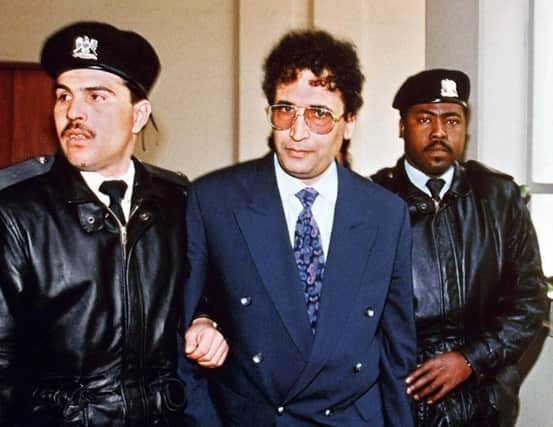Dr Jim Swire: Lockerbie: seeking the truth


Our elder daughter Flora, aged 23 and a seeker after truth herself, was on her way to meet her American boyfriend that night. She would have walked excitedly down those long airport corridors.
She never knew, and it took us until 2001 to discover, that Heathrow Airport’s “airside” had been broken into 16 hours before Pan Am Flight 103 exploded – and just where the bags converging for the Lockerbie flight were to be assembled on 21 December, 1988.
Advertisement
Hide AdAdvertisement
Hide AdTry to imagine what it is like to know that your daughter went, unaware of her danger, through the corridors of an airport which knew that its “secure” airside had been broken into, and knew that there was a high terrorist threat to US aircraft at the time and yet still decided not to investigate who had broken in or what his motive might have been. Then try to imagine that you have tried in every way you can think of for 25 years to get an inquiry into why Lockerbie was not prevented and how things could be improved for the future, and been blocked at every stage.
It also took us until 2012 to get official confirmation – in a letter to me from the former Chief Constable (Dumfries and Galloway police) Patrick Shearer – that the investigating police had had complete files about that break-in in their computer from February 1989. That letter also explained that the file had been passed to the Crown Office before the trial of Abdelbaset Ali Mohmed al-Megrahi had even started. Yet still the prosecutors failed to share their knowledge with the defence.
It is probable that the suppression of this break-in evidence was caused by blind adherence to the hypothesis that the bomb must have come from Malta because of some associated clothing that had indeed originated there. Once a force has formed a strong hypothesis, it takes an earthquake to convince it that other evidence, particularly if hostile to the favoured hypothesis, ought to be shared with the defence. That is a problem we see again and again in miscarriage of justice cases.
The Megrahi defence team had tried to defend him in court by “incrimination” – where they would show that others, not their client, had used a bomb of a type known to have been available to terrorists then but which would always explode between 30 and 45 minutes after any plane containing one had taken off.
Therefore, their case depended upon being able to show that somehow the bomb must have been introduced at Heathrow Airport or else it would have exploded 30-45 minutes after leaving a previous airport of origin. The Lockerbie aircraft flew for 38 minutes.
The United Nations special observer to the trial (Professor Hans Koechler of Vienna) was in no doubt that it did not represent justice. How could it have done when the break-in information describing an obvious possible avenue for the introduction of the bomb at Heathrow was simply denied to the defence? There were other signs of something far more sinister: Early in 1990, we UK relatives were called to the US embassy in London. In an aside to one of us there, an American official said privately of Lockerbie: “Your government and ours know exactly what happened, but they’re never going to tell.”
Then, in 1993, the late Baroness Thatcher wrote of her support for the 1986 US air force (USAF) raid on Libyan leader Colonel Muammar al-Gaddafi: “It turned out to be a more decisive blow against Libyan-sponsored terrorism than I could ever have imagined…the much vaunted Libyan counter-attack did not and could not take place.” Yet two years before, in 1991, two Libyans had been officially blamed for the Lockerbie bombing.
In our search for truth, we relatives of the Lockerbie bombing victims met Nelson Mandela. He warned us that in a trial “no one country should be complainant, prosecutor and judge”, yet Scotland became all three. He set up the truth and reconciliation commission in South Africa. But how can one have reconciliation without the truth?
Advertisement
Hide AdAdvertisement
Hide AdGaddafi, too, we met, leaving him with a badge that said: “Lockerbie, the truth must be known.” With his consent, we also left a framed message with a picture of Flora on the wall of a family bedroom badly damaged in the 1986 USAF bombing of Tripoli. It read in English and Arabic: “The consequence of the use of violence is the death of innocent people.”
It remained there for years – to be destroyed finally by a Nato bomb. A message for us in the West perhaps?
In the post-Snowden world, we all know how extensive is the reach, even among their own citizens, of US and UK intelligence gathering. What we do not know is what aspects of that intelligence are deliberately hidden from citizens who desperately need access to it in their grief, or indeed why any of it should be kept from them.
We relatives need the truth about who murdered our families and article 2 of human rights legislation guarantees our right to have it. While that truth is hidden, the true perpetrators are protected.
Next year, in the face of the blank refusal of governments to mount any meaningful inquiry, certain relatives will apply to the Scottish Criminal Cases Review Commission for a further appeal against the Megrahi verdict. It is likely that some of us will also pursue other routes to force an honest inquiry out of obdurate governments; 25 years is too long, and we should not be opposed by our own elected governments.
If you look at terrible UK disasters – Northern Ireland and the IRA trials, the Hillsborough disaster and also Lockerbie, it is the denial of truth to the victims that is the common thread. So, indeed, there is a thread and that thread is truth.